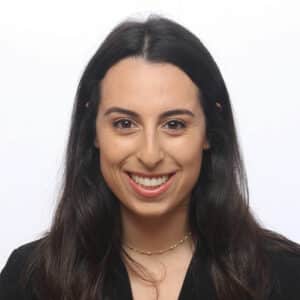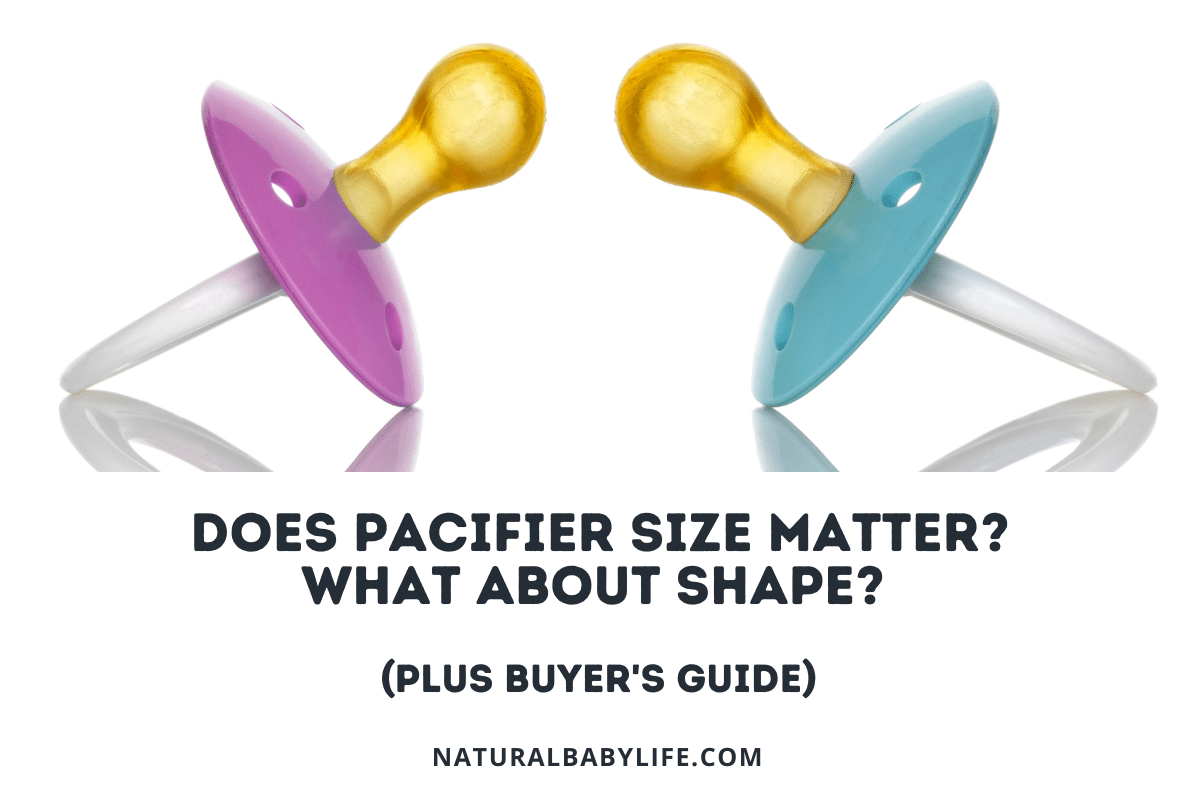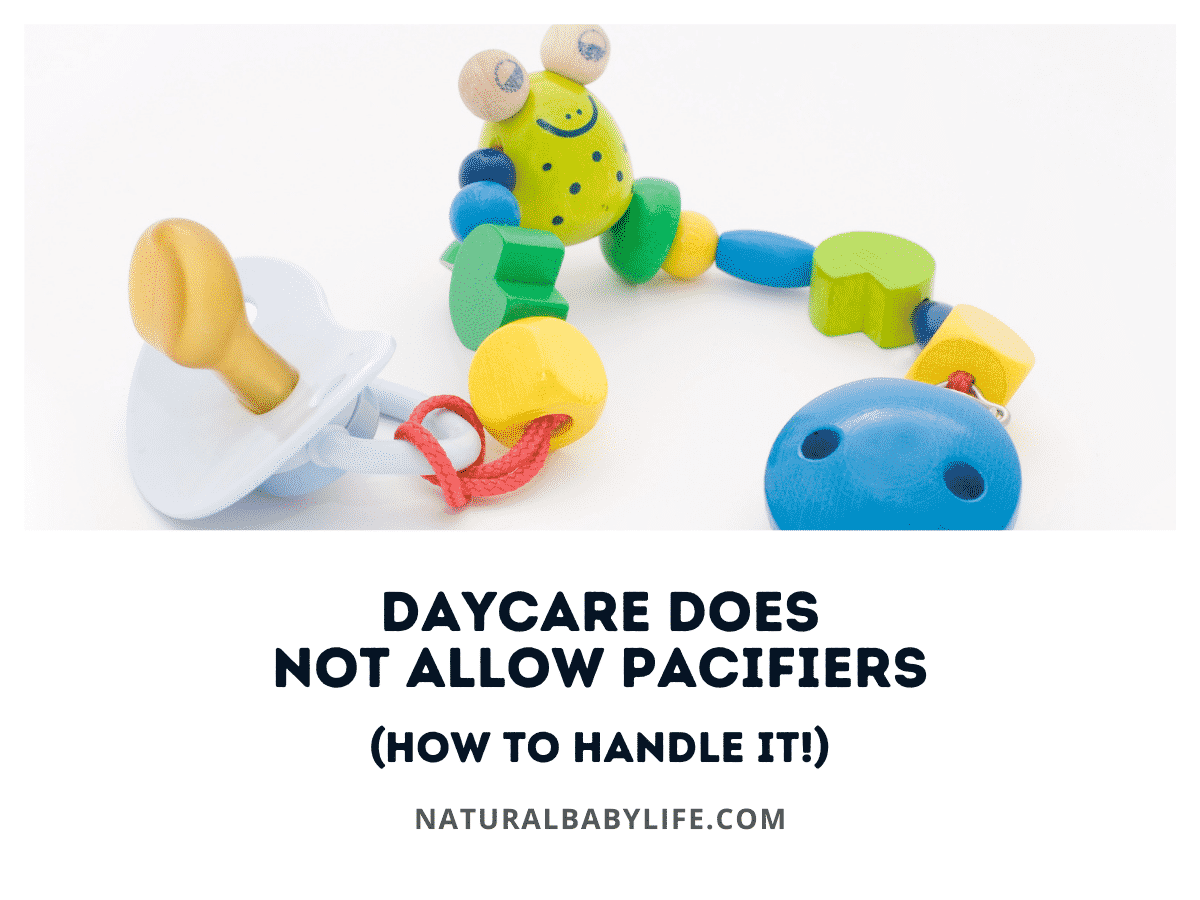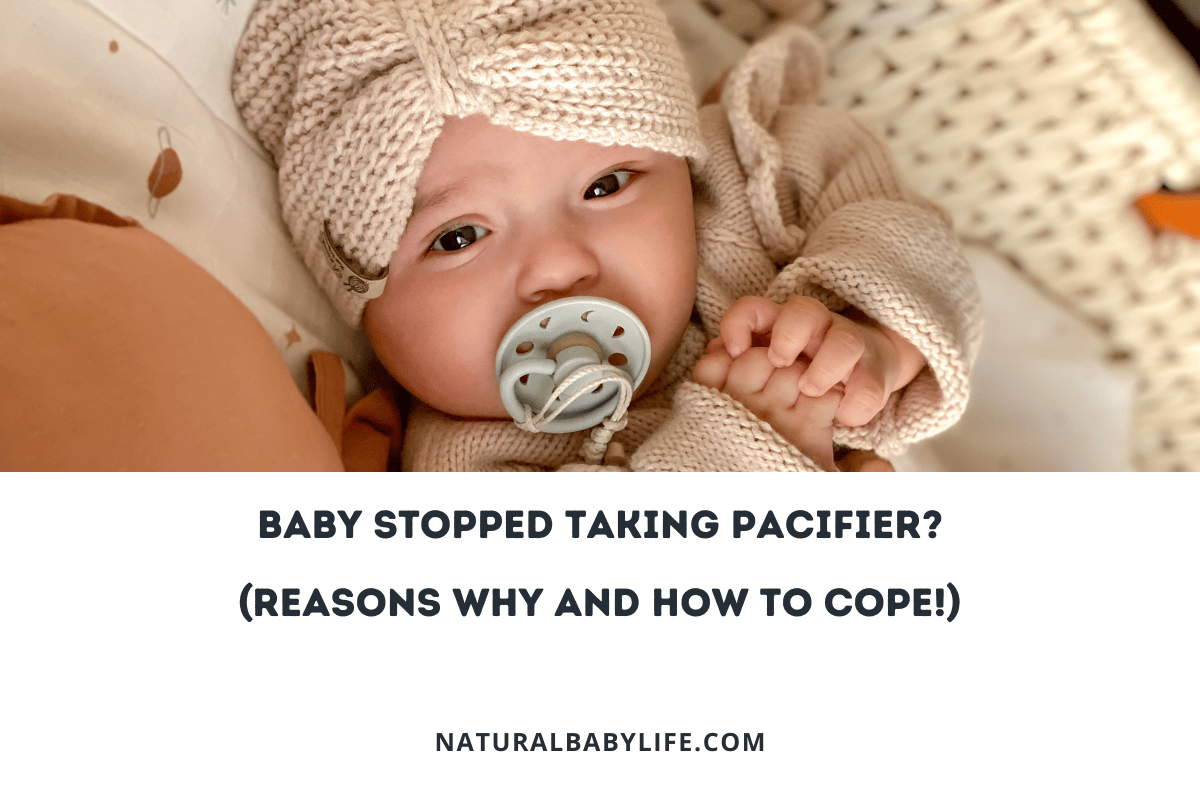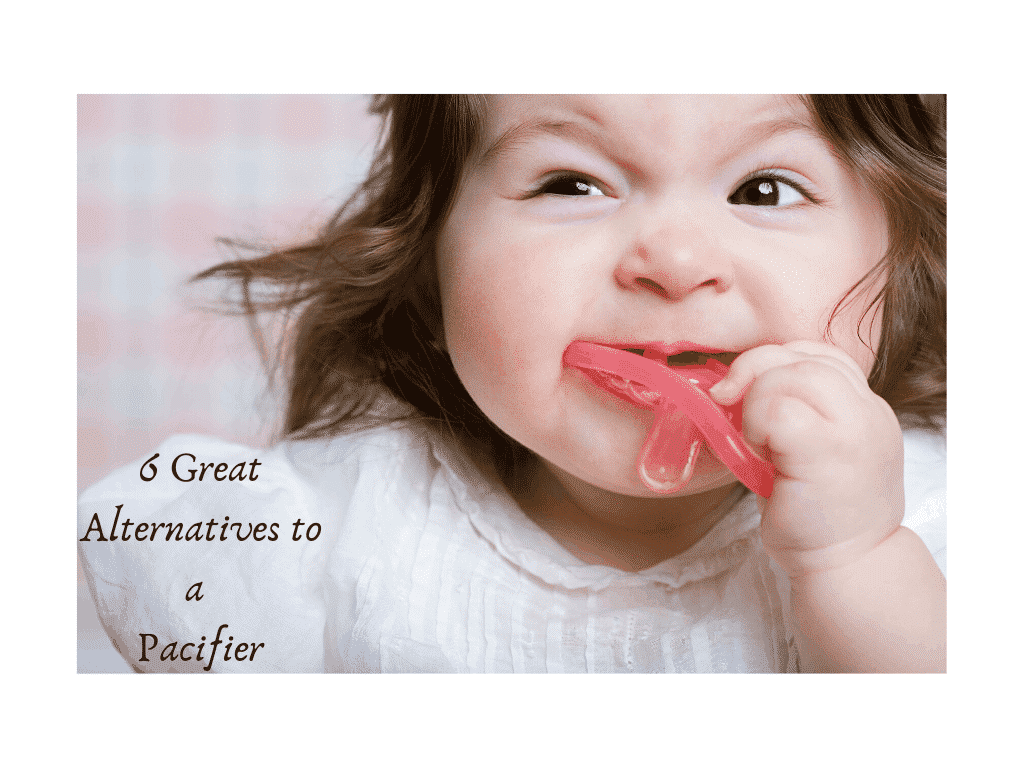Most parents will have the moment where they wonder why can’t Baby keep pacifier in mouth! It’s such a helpful soothing tool for babies, but it can instead become a point of frustration if your baby keeps spitting it out. Let’s look at when and how to introduce the pacifier and what to do if your baby isn’t keeping it in their mouth.
If you’re breastfeeding, you may want to wait to introduce the pacifier until you’ve established breastfeeding, which can often take 3-4 weeks. Otherwise, you can immediately introduce a pacifier! You may need to try different pacifiers to find the right one for your baby.
Read on to learn tips on helping babies learn to keep the pacifier in their mouth and when you will be able to stop replacing it for them.
Table of Contents
When to start using a pacifier
Babies are born with a sucking reflex, so when a nipple (it could be a breast, bottle, or pacifier) is put in the baby’s mouth, she will naturally begin to suck. That does not mean, however, that baby will do it with great efficiency or ease at first. Even though it’s a reflex, the baby still needs practice to master this skill.
- If you are breastfeeding Baby, it’s recommended that you establish a nursing routine before you introduce a pacifier, typically four to six weeks after birth. This is suggested to try and prevent any kind of nipple confusion, where the baby may find it easier to suck on a pacifier nipple and struggle to latch on to mom when nursing.
- If a baby is exclusively formula- or bottle-fed (for those moms exclusively pumping), then the baby can begin using a pacifier immediately.
Not only will the baby find comfort from using a pacifier, but parents do too since the use of pacifiers helps to reduce the risk of Sudden Infant Death Syndrome (SIDS).
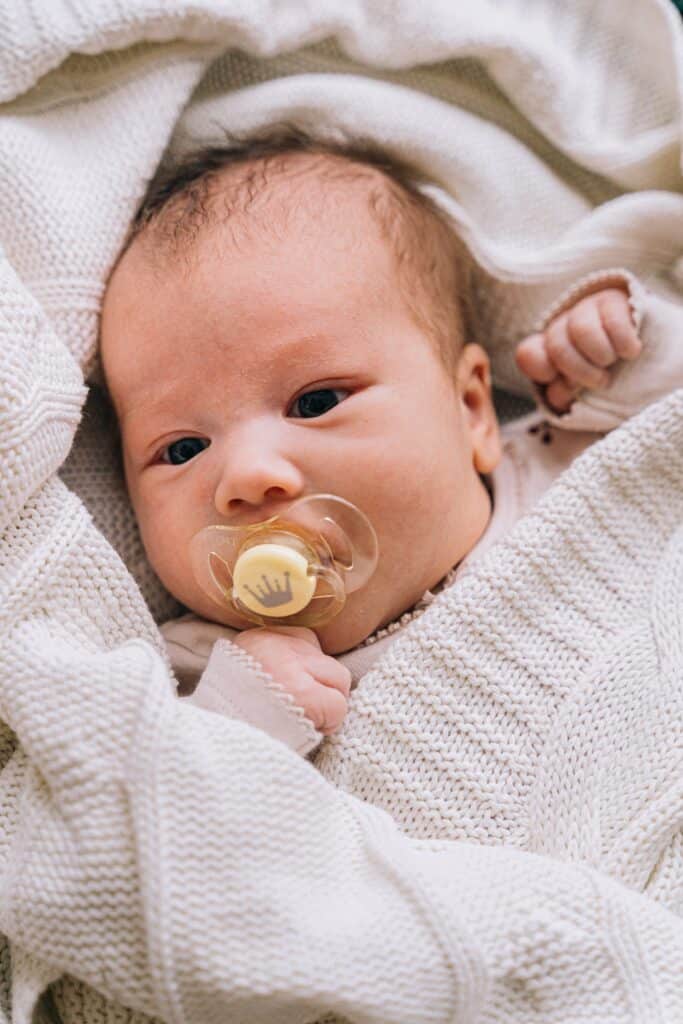
How to introduce a pacifier
When you’re ready to start trying to introduce a pacifier into your baby’s routine, you need to make sure everything (and everyone) is ready.
- Ensure that your baby is in the right mood. You want to do it when the baby is content, not upset. Trying to introduce something new while your baby is frustrated could lead to an ongoing negative association with the pacifier – the last thing you want!
- Sanitize the pacifier. Make sure the pacifier has been boiled and is clean since their immune systems are still a work in progress.
- Timing is important. Offer the pacifier after a meal or at bedtime, so that the suckling of the pacifier doesn’t replace a meal.
- Don’t give up. If the baby doesn’t take the pacifier on the first try, that’s okay. Don’t force it. You can try again later.
If you haven’t already picked up a pacifier to try then I highly recommend picking up a pacifier with an orthodontic shape made from natural materials to help prevent any future issues!
When can a baby hold a pacifier in their mouth
As soon as the baby begins to use a pacifier, the focus then becomes helping the baby keep the pacifier in their mouth. Even if your baby loves the pacifier, it’s common for the binky to fall out of their mouth when they fall asleep as their muscles relax.
When babies reach three months, they begin to reach for objects and hold small things in their hands. At that point, they might start grabbing for their binky. Unfortunately, they probably won’t have the coordination to put it back in their mouths.
Babies can consistently get their pacifiers back in their mouths at 7 months old. This ability comes coupled with having mastered several gross and fine motor skills such as moving objects between their hands and pulling things toward their mouth.
Why can’t baby keep pacifier in mouth
Of course, your baby may need a little help learning how to keep the pacifier in.
You’ll likely be replacing it for them for quite a while until they develop the motor skills to put it in their mouth themselves, but there may also be underlying issues with the shape of the pacifier or your baby may have a lip or tongue tie.
If the pacifier doesn’t fit in your baby’s mouth, you may need to try a different one. Pacifiers are sold in various shapes and sizes. And, all babies are different.
Some babies’ mouths are very small, while others are quite large. If the baby can’t seem to keep the pacifier in her mouth, it could just be a bad fit. It’s best to try a variety of pacifiers to see which one works best for the baby.
Sometimes baby just won’t keep the pacifier in her mouth, ranging from the way it feels to just not being in the mood.
- It doesn’t feel good – The pacifier may not be the right size or fit for your baby. It can take a few tries with various brands to find the perfect one. And once you do, make sure you stock up.
- It doesn’t taste good – The taste of a pacifier is unfamiliar to babies and they may not like it at first. To get them interested initially, you could coat it in breast milk.
- It’s food time – If baby is hungry, the pacifier will satisfy the sucking reflex, but not fill her up. So, she may spit the pacifier out.
- They’re done with it – Sometimes a baby may not want the pacifier, which is completely normal.
- Physiological problems – if your baby has a tongue or lip tie, the pacifier won’t be satisfying.
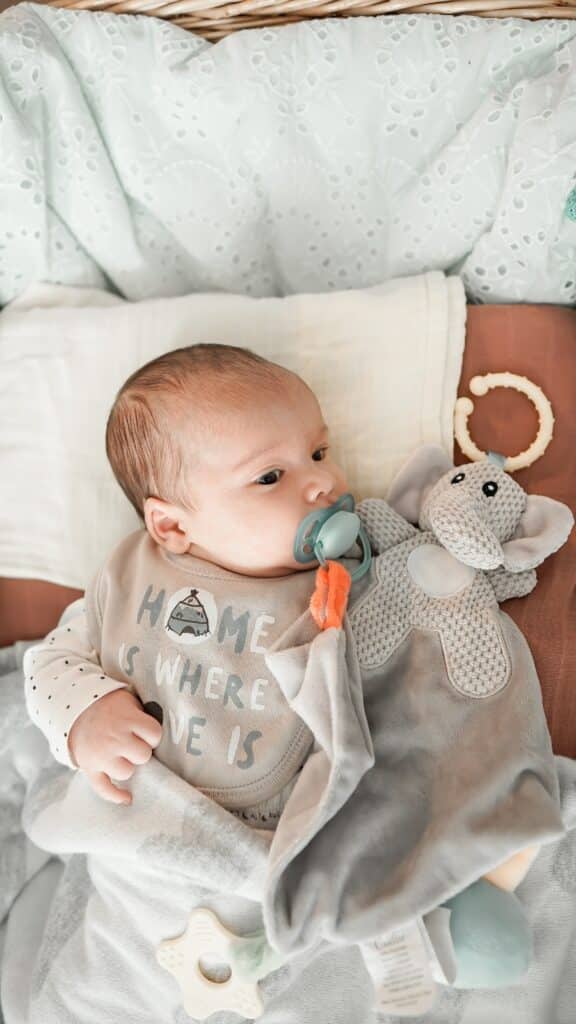
Can babies with a tongue tie use a pacifier
Some babies are born with a tongue tie or lip tie, which means the baby has an extra bit of tissue on the tongue or lip that limits movement.
Tongue ties anchor the tongue to the bottom of the mouth, and sometimes it’s totally fine. In many cases, it can cause speech problems. Before that, you might notice that your baby has trouble eating and swallowing.
Tongue ties can make sucking a challenge, so a pacifier just might be too much work and not a rewarding soothing tool for your baby.
With a lip tie, it’s difficult to suck because it’s difficult to move the upper lip. Just as babies with a lip tie struggle to breastfeed, they also struggle to keep a pacifier in their mouth.
It is recommended that babies with a tongue tie use a pacifier that is one piece; you may also want to look into having your baby’s tie surgically corrected by a pediatric dentist.
If you think your baby might have a tongue or lip tie, your baby’s pediatrician or a pediatric dentist can diagnose them.
How to keep a pacifier in your baby’s mouth
A baby may need your assistance learning how to keep the pacifier in her mouth.
Sucking is a natural reflex, but, like many things, she will need your help. It’s important to make the experience a calm, positive one when you are teaching a baby how to do this. Remember, everyone benefits when a baby learns to keep the pacifier in her mouth and sleeps soundly at night.
Several things can help encourage the baby to keep the pacifier in her mouth, including using a little reverse psychology and teaching her to suck on the pacifier to keep it in. But it all starts with finding the goldilocks of pacifiers – the one that is the perfect fit for her.
Find the right pacifier
Making sure your baby has the right pacifier is key to getting her to keep it in her mouth.
There are several things to consider when purchasing a pacifier:
- Nipple shape – Bulb-shaped pacifiers are different than orthodontic pacifiers.
- Mouth shield – Some pacifiers are one single piece with a full circular mouth shield, while others are plastic.
- Handle – The handle on the pacifier could be a ring or a button.
- Baby’s age – Pacifiers are often offered in different sizes, for 0-3 months, 0-6 months, and 6-18 months. The 0-3 month and 0-6 month pacifiers are shorter and smaller than the 6-18 month pacifier.
Overall, it’s important to see what works best for your baby. What worked for your friend’s baby may not work for yours.

Coat it in breast milk or formula
If baby doesn’t seem interested in her pacifier, it could be because she doesn’t like the taste.
You could put a little bit of breast milk or formula on it so that the baby likes the taste. While breast milk or formula is okay to use, you should never coat the pacifier in something sweet like honey or syrup.
Make it a game
A great way to help baby learn to keep her pacifier in her mouth is to make it a little game.
Put the pacifier in her mouth and then, gently, try to pull it out. You will immediately notice her sucking harder to try and keep it in her mouth. Baby AND parent win!
Use a pacifier leash
My favorite pacifier tip is to use a pacifier leash. Then, when your baby inevitably spits out their binky, you don’t have far to look to find it.
Additionally, it’ll be easier for your baby to learn to put their pacifier back in their mouth if it’s just a few inches away on a string rather than who knows where across the floor.
However, you shouldn’t let your baby sleep with a pacifier leash or a pacifier attached to a stuffy or blanket because they could pose suffocation risks.
What happens if the baby never takes a pacifier
Even if your baby never takes a pacifier, it’s not a big deal. Every baby is different, and some babies just don’t like pacifiers and that’s okay.
In fact, not having to wean the baby away from the pacifier doesn’t sound too bad!
Never force a baby to take a pacifier
It’s important to never force the baby to take a pacifier. If she continually spits it out, don’t force it. It’s important to remember that the point of the pacifier is to soothe the baby and forcing it will only upset her.
Baby keeps pulling the pacifier out of their mouth
If the baby keeps pulling the pacifier out of her mouth, she may not want it or need it. Remember some babies really do take to binkies more than others.
Some babies are able to self-soothe and even prefer sucking on their thumb. It could also be an issue with fit or even hunger.
Baby pushes pacifier out with tongue
Your baby may not be able to keep the pacifier in because she is pushing it out with her tongue.
This could be because the baby doesn’t want it or it could just be a reflex. The orthodontic type pacifier may help prevent this in babies.
Can a pacifier cause tongue thrust?
Using a pacifier for a long period of time can result in tongue thrust when the tongue protrudes between the front teeth while speaking and swallowing. This is why it is generally recommended to wean a baby from the pacifier by two years old.
Conclusion
There can be a lot of trial and error involved in getting some babies to take the pacifier. For others, it comes naturally and they can’t get enough of the binky.
The best ways to encourage pacifier use are to try several to find the right fit for your baby and to be patient. And, remember, your baby probably won’t be able to replace their own pacifier until they are about 7 months old.


